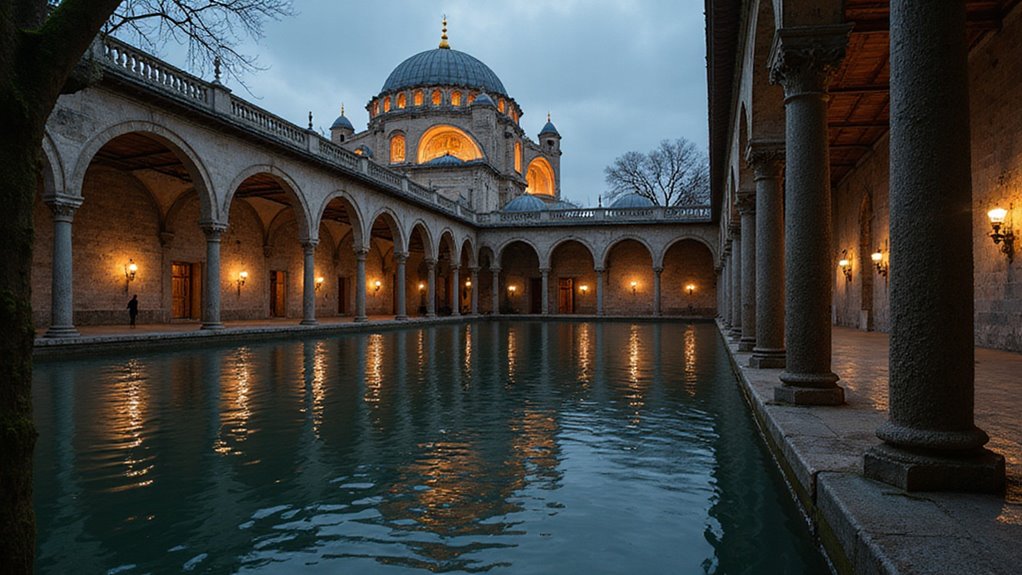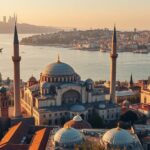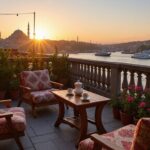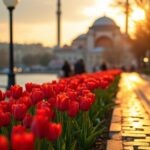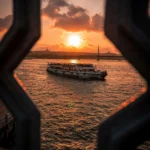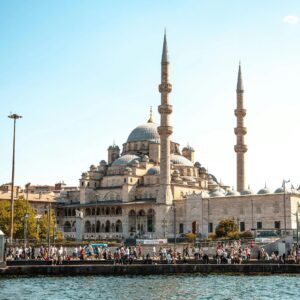Topkapi Palace and Basilica Cistern sit at Istanbul’s historic core, offering Ottoman grandeur and Byzantine secrets. You’ll explore imperial courtyards, the Harem, jeweled Treasury, and shaded gardens with panoramic Bosphorus views. Move between sites by tram or a taxi ride, buy timed tickets in advance, and allow three to four hours for both attractions. Expect low-light conditions in the cistern, keep voices low, and bring steady camera gear. Continue for practical tips and deeper context.
Key Takeaways
- Topkapi Palace: 15th-century Ottoman imperial residence showcasing courts, pavilions, İznik tiles, and the dazzling Imperial Treasury.
- The Imperial Harem reveals private court life, hierarchical politics, ornate chambers, and guided-tour context.
- Basilica Cistern: a 6th-century Byzantine underground reservoir with 336 reused columns and iconic Medusa bases.
- Visit tips: buy timed tickets, consider guided tours, arrive early, and purchase the Harem ticket separately.
- Accessibility and photography: low light, slippery paths; check wheelchair access, avoid flash, and allocate extra time for photos.
Historical Background of Istanbul’s Palaces and Waterworks
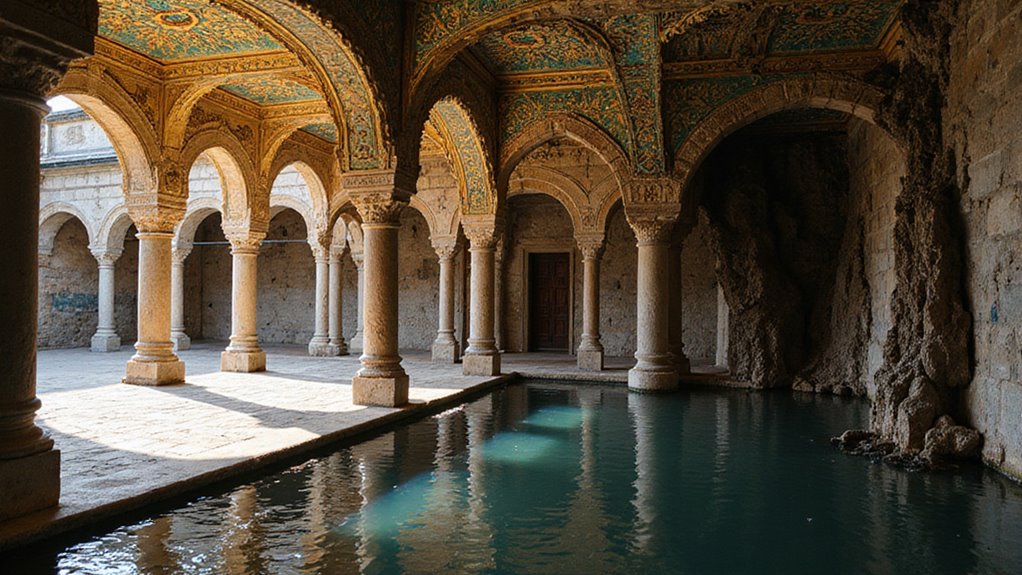
When visiting Istanbul, you’ll want to plan ahead to see both Topkapi Palace and the Basilica Cistern efficiently. Explore Hagia Sophia nearby, and allow time to understand Byzantine roots and Ottoman transformations. Visit ancient aqueducts along the city, observe engineering that supplied water across centuries.
Walk through restored caravan routes, then study Ottoman court life at several historic palaces. Use public transit to cut travel time, choose off-peak hours for shorter lines.
Stroll restored caravan routes, then delve into Ottoman court life at historic palaces.
Visit Basilica Cistern early morning, enjoy cool atmosphere, candlelit stone, and tranquil pools. Explore urban waterworks museums and displays, learn about maintenance, distribution, and ancient preservation techniques.
Use guided tours for context and skip-the-line access, book online, confirm meeting points. Plan flexible days, include time for walking, photography, food, and relaxed exploration of historic neighborhoods.
Visit local kiosks for maps, tickets, and tram passes to simplify transit. Explore ferry routes for scenic commutes across the Bosphorus.
Topkapi Palace: Key Architectural Highlights
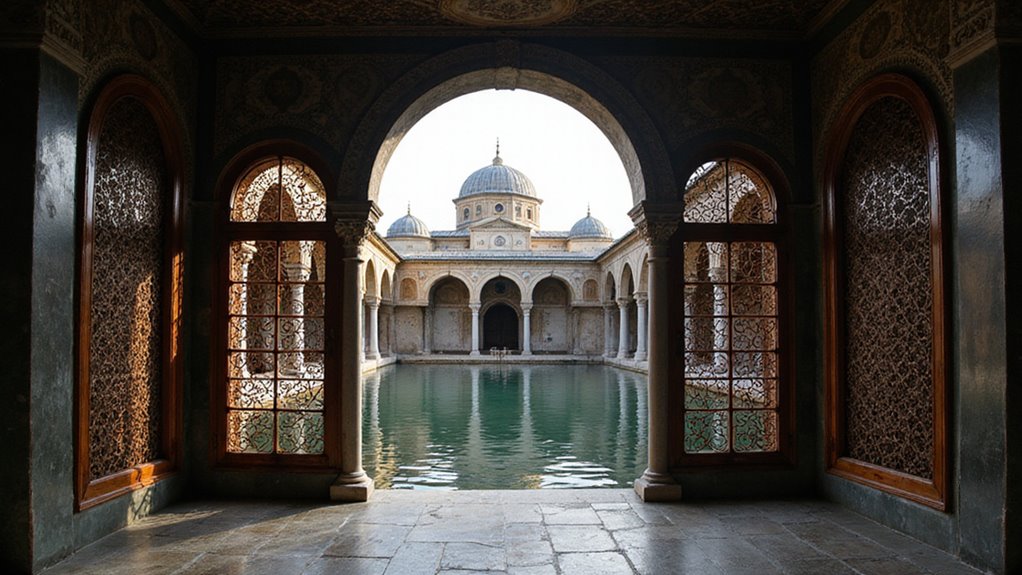
Topkapi Palace sits a short walk from the Basilica Cistern and Hagia Sophia, making combined visits convenient.
Hagia Sophia provides a landmark starting point, and tram access connects directly to Sultanahmet station.
Visit the outer courtyards first, admire broad walkways, and note ornate gates and panoramic views.
Explore the Imperial Treasury next, where jeweled artifacts are displayed with careful lighting and clear labels.
Walk the palace gardens slowly, enjoy shaded paths, Ottoman fountains, fragrant trees, and distant Bosphorus glimpses.
Take the tram to Sultanahmet, buy timed tickets online, and allow extra time for security checks.
Plan to arrive early during peak season, avoid long queues, and reserve guided tours for deeper context.
Bring a lightweight scarf or modest cover, follow signage, respect exhibits, and observe historical courtly attire displays.
Enjoy decorative tiles, exquisite calligraphy, domed chambers, tiled kiosks, and vivid colors that showcase imperial craftsmanship for informed travelers.
The Imperial Harem and Private Quarters

Imperial Harem’s private quarters reveal the intimate life of the Ottoman court, with ornate tiles, gilded doors, and carved wooden screens. Topkapi Palace offers guided tours that explain harem politics, concubine hierarchy, and household routines. Visit the Quarter early to avoid crowds, secure timed tickets, and join an expert guide.
Harem corridors display colorful İznik tiles and intimate chambers that reflect domestic life. Guided walks last about one hour, include nearby courtyards, the palace kitchens, and museum galleries. Explore the private rooms slowly, read interpretive signs, and respect photography rules inside.
Sultan’s quarters remain off limits in parts, so plan extra time for adjacent displays and archives. Take tram or ferry, then walk through Gulhane Park to the palace gates. Istanbul guides can customize visits, emphasize harem politics, concubine hierarchy, private quarters, and visitor comfort. Bring water, wear comfortable shoes, book tickets online to skip long lines today.
The Palace Treasury and the Sultan’s Jewels
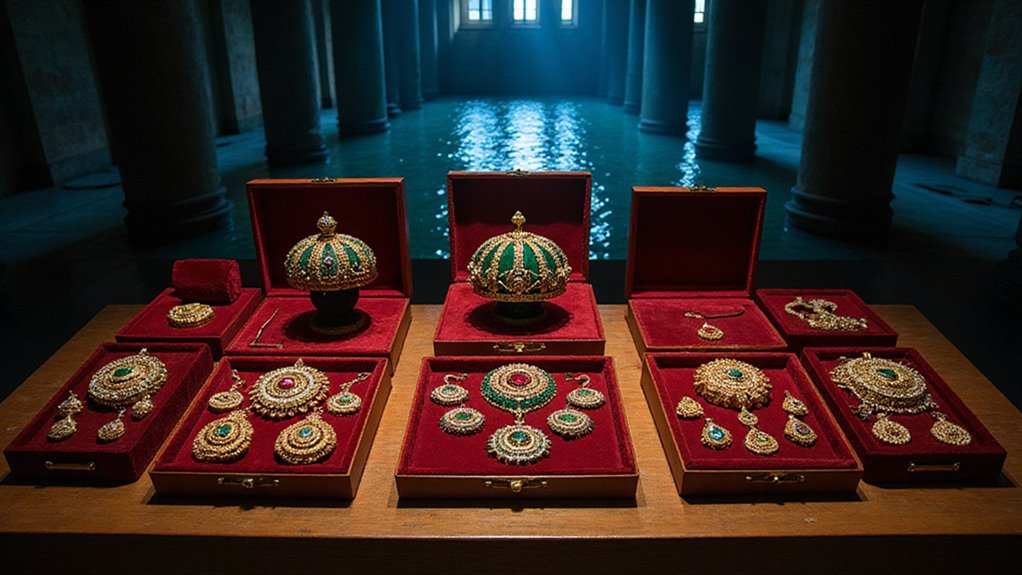
At the Palace Treasury, you’ll see the Sultan’s jewels, dazzling gemstones, bejeweled crowns, and imperial daggers. Topkapi Palace presents an impressive jewel collection, and you should allow at least ninety minutes to explore.
Visit the Treasury early, avoid crowds, and use an audio guide for context and clear descriptions. Hagia Sophia views await nearby, so plan combined visits, and take a taxi or tram for quick transfers.
Entrance lines vary seasonally, so book skip-the-line tickets when possible, and arrive with a printed or digital reservation. Topkapi exhibits royal artifacts in secure, glassed displays, and guards guarantee careful observation.
Photo rules vary, so check signage, and carry small bills for lockers and restrooms. Security checks are standard, so travel light and bring ID.
Museum shops offer quality replicas, and you can purchase guidebooks, maps, and souvenirs. Guided tours provide deeper stories, and they enrich your visit efficiently, confidently explore.
Courtyards, Pavilions and Gardens of Topkapi
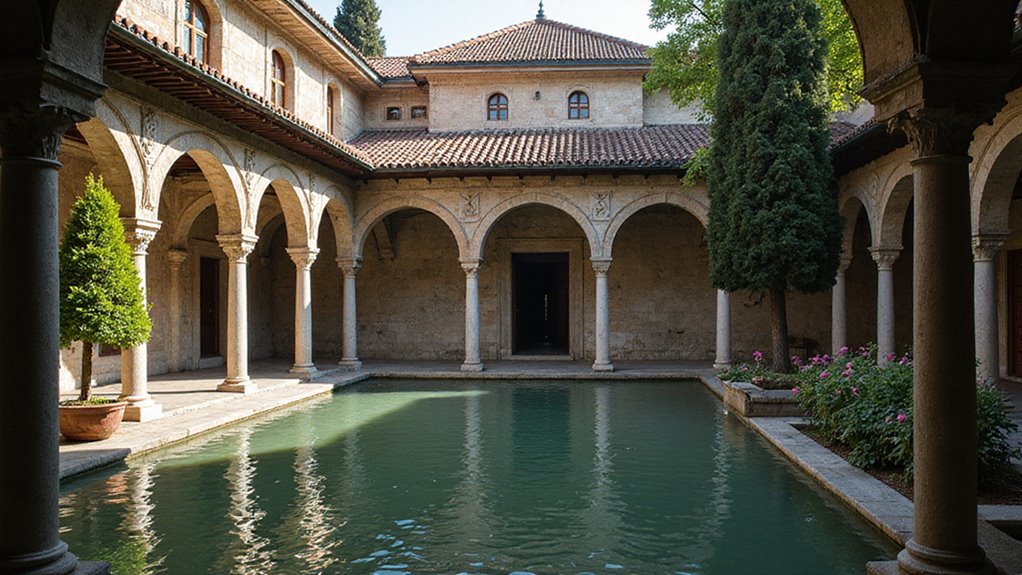
First Courtyard will welcome you with broad walkways, historic gates, and easy ticket checkpoints, so arrive early.
Second Courtyard offers open views, shaded pavilions, and panoramic city outlooks for relaxed exploration.
Imperial pavilions display carved woodwork, tiled rooms, and serene terraces that invite lingering.
Carved woodwork, tiled chambers, and tranquil terraces in the imperial pavilions invite lingering and quiet admiration.
Gardens show deliberate landscape design, fragrant plantings, winding paths, and seasonal blooms for peaceful pauses.
Fountain courts highlight water features, reflecting pools, and shaded benches for cool breaks.
Gatehouses mark shifts, offer informative plaques, and guide you between areas efficiently.
Transport advice: use tram lines to Sultanahmet, arrive before midday, and wear comfortable walking shoes.
Tickets often include audio guides, timed entry, and combined passes that save money and time.
Maps at the entrance, staff directions, and clear signage keep your route simple and efficient.
Topkapi grounds encourage slow wandering, photography, picnic breaks, and contemplation amid historic vistas, with clear restroom locations noted nearby.
Religious, Ceremonial and State Spaces

Harem tour shows richly decorated chambers, private mosques, and ceremonial halls that shaped court life. Topkapi Palace invites you to explore sacred rooms, ornate chapels, and the Imperial Council chamber where royal ceremonies echoed.
Basilica Cistern offers cool, atmospheric relief, reduced crowds in early morning, and unique lighting for photos.
Harem ticketing requires separate entry, reserve online to skip lines, arrive early for clearer viewing.
Palace map helps you navigate courtyards, pavilions, and the treasury displays, prioritize highlights to manage time.
Harem guides explain symbolic spaces, prayer alcoves, and ceremonial routes used during state rituals.
Sultan’s private mosque remains a quiet, reflective stop, accessible by short walks between wings.
Guided tours last about two to three hours, include audio options, and suit travelers seeking depth.
Visitor facilities include restrooms, lockers, and nearby cafes, making your visit comfortable and efficient.
Topkapi signage, helpful staff, and clear routes improve accessibility.
Daily Life and Administration in the Ottoman Court

Topkapi Palace reveals daily life and administration through courtyards, offices, private chambers, and ceremonial rooms.
Visit the Imperial Council chamber to learn how decisions were made, see manuscripts, maps, regalia.
Harem apartments show intimate routines, strict court etiquette, well organized service, and private leisure spaces.
Explore the Gate of Salutation, the kitchens, the treasury, and the viewing terraces for practical context.
Topkapi’s layout connects courtyards, service areas, treasury, and viewing terraces, offering clear logistical flow.
Observe preserved schedules posted in rooms, imagine daily schedules, ceremonial timings, and the rhythm of palace life.
Imperial staff functions are explained clearly, showing ranks, responsibilities, communication channels, and administrative flow.
Hagia Sophia views, Bosphorus walks, and guided commentary enhance your understanding, making a visit both educational and liberating.
Explore adjacent landmarks, Sultanahmet Mosque, archaeological museums, and vibrant bazaars.
Use exhibits, archival displays, guided commentary, and interpretive signage for fuller historical perspective, context.
Practical Tips for Visiting Topkapi Palace
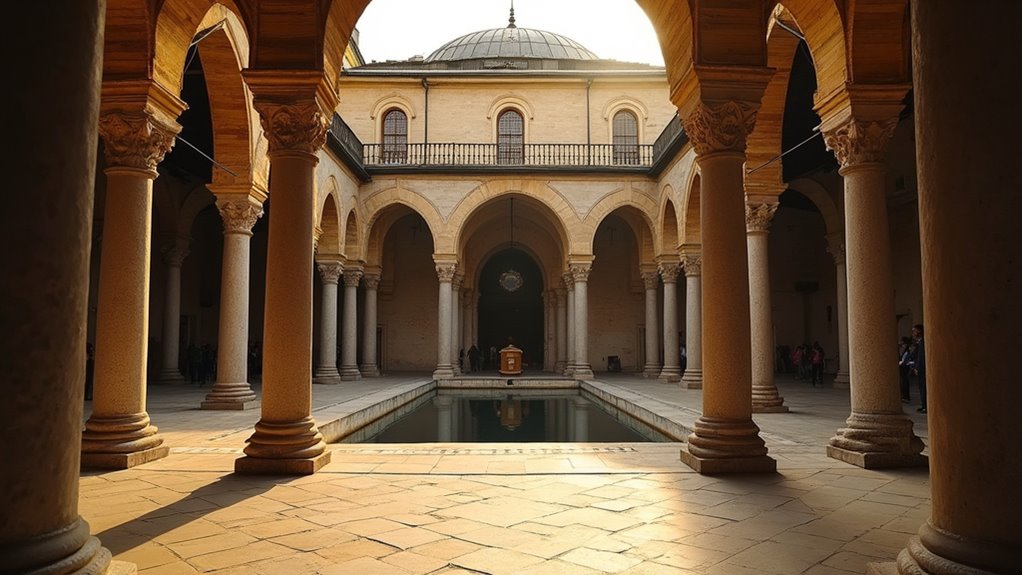
Visiting the palace, you’ll want to arrive early to beat crowds and enjoy cooler, quieter rooms. Arrive by tram or ferry for easy access, follow signs to the main gate. Take a guided tour to reveal hidden stories, entertaining, informative guides provide focused insights.
Topkapi Palace, buy the Harem ticket separately, plan at least two hours minimum. Enter the courtyards early, enjoy ornate pavilions, treasury exhibits, porcelain rooms and panoramic Bosphorus views.
Take breaks in shaded gardens, hydrate, and use nearby cafes for light meals and rest stops. Buy audio guides or join small groups, they’ll move at a comfortable pace and answer questions.
Visit souvenir shops after sightseeing, compare prices, choose handcrafted items, and support local artisans. Plan transport back to Sultanahmet, allow time for security lines, and keep personal items secure.
Consider weekday mornings for freedom, check opening hours, and book tickets online to save time.
Origins and History of the Basilica Cistern
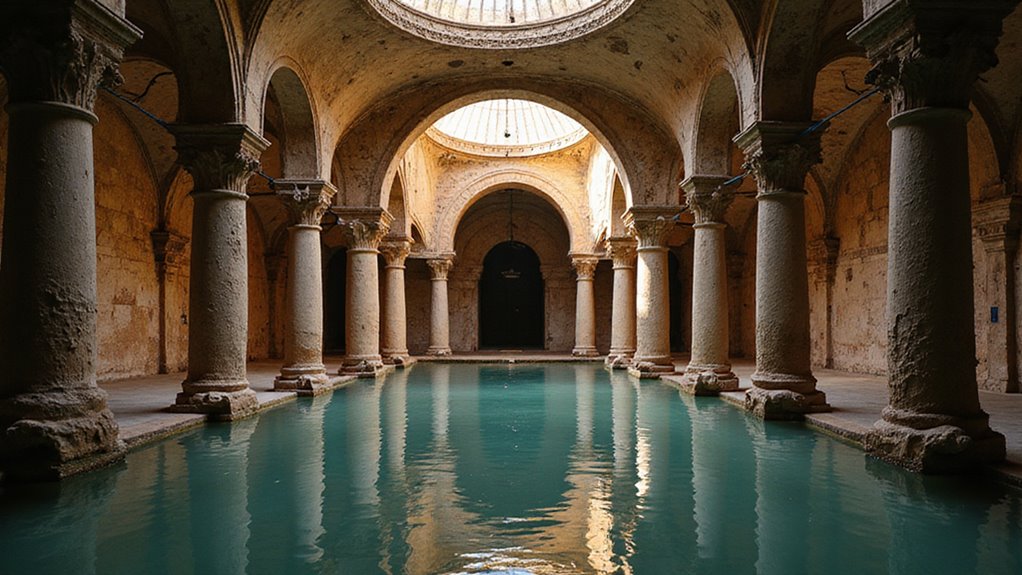
Istanbul’s Basilica Cistern was constructed in the 6th century under Emperor Justinian, functioning as the city’s primary subterranean water reservoir. Explore the site’s early purpose, and learn how this underground reservoir supported palaces, baths, and daily life.
Visit nearby Hagia Sophia, Sultanahmet Square, Topkapi Palace, and then plan your Basilica Cistern stop efficiently. Take guided tours to gain historical context, hear stories about Byzantine rulers, and understand civic priorities.
From museum passes to timed entry, you should book tickets online, especially during peak season. Nearby transport links include tram stops, buses, and pedestrian routes that connect you to hotels, restaurants, and other attractions.
Consider visiting early morning or late afternoon to avoid crowds, capture dramatic lighting, and move at your own pace. Walk carefully on wet surfaces, wear comfortable shoes, and respect conservation rules to preserve this historic site.
Experience evocative atmosphere, and appreciate ancient water filtration methods.
Engineering, Design and Structure of the Cistern
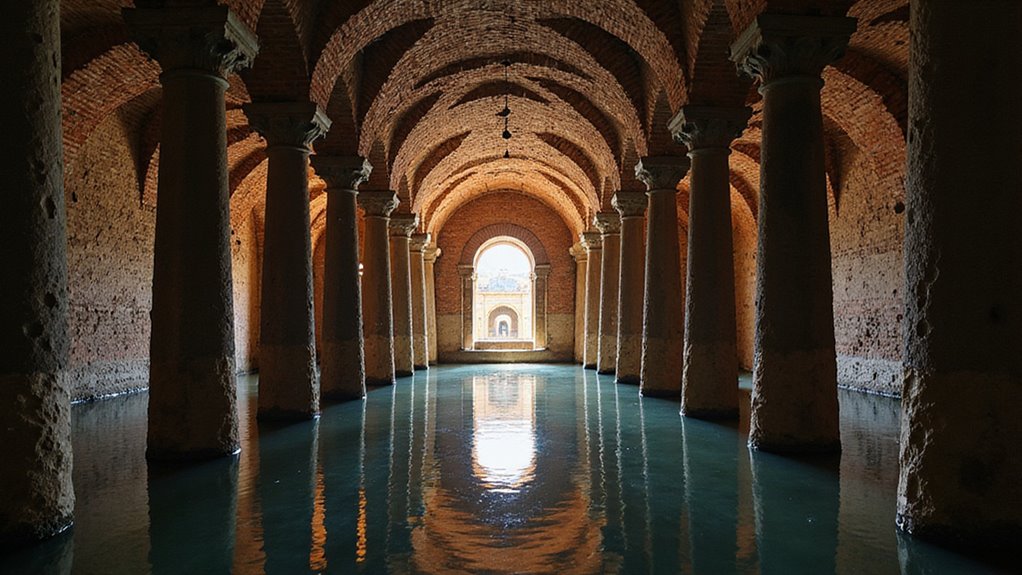
Basilica Cistern’s vast vaulted chambers show advanced Byzantine engineering, with 336 marble columns supporting intersecting brick arches. Sultanahmet visitors will notice the cool, echoing space that once stored imperial water supplies. Topkapi Palace lies nearby, and you can combine both in a single morning tour. Hagia Sophia offers complementary history, and walking transfers take under ten minutes.
Arrival suggestions include tram line T1, modest entrance fees, and timed tickets to avoid lines. Underground engineering reveals subtle water filtration systems, and you can observe how flow was managed. Column materials include reused Roman marble, granite drums, and sculpted capitals, and you should examine varied textures closely.
Guided tours provide clear explanations, and audio guides let you explore at your pace. Ticket counters advise arrival forty-five minutes before closing, and staff permit brief photography without tripods.
Departure options include cafés, museums, and scenic viewpoints, ensuring a practical, memorable visit today.
The Medusa Heads and Other Sculptural Details
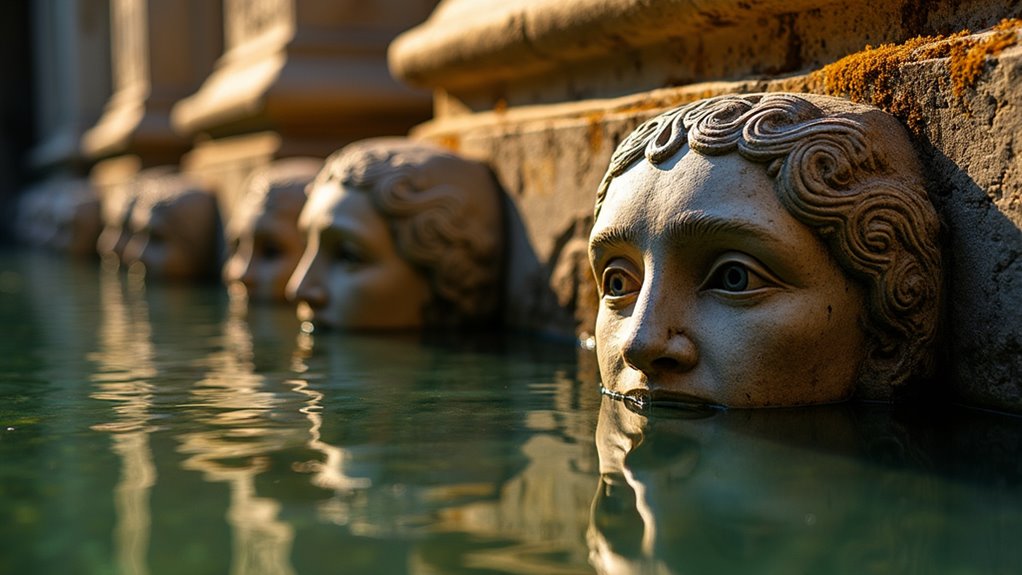
At the Sultanahmet cistern you’ll find two striking Medusa heads repurposed as column bases, one placed sideways, the other inverted. When you arrive, note the blend of sculptural symbolism, carved capitals, and reused stonework throughout the complex.
Sultanahmet area maps show transit options, tram stops, and walking routes to reach the cistern quickly. Entering through the main access, you can pair the visit with Topkapi Palace, Hagia Sophia, and the Blue Mosque nearby.
Guided tours explain the artistic influences, provenance theories, and conservation efforts in clear, engaging language. Purchasing tickets in advance, use official kiosks or apps to avoid lines during peak hours.
Join a guided tour for clear, engaging insights — buy tickets via official kiosks or apps to skip queues.
Nearby transport hubs include Sultanahmet tram, Eminönü ferry, and central bus links for flexible scheduling. Walking the stone pathways, you’ll appreciate reused Roman and Byzantine reliefs, subtle motifs, and restored elements.
Allow forty-five minutes to explore sculptural details, read plaques, and consider recent historical interpretations.
Atmosphere, Sound and Photography in the Cistern
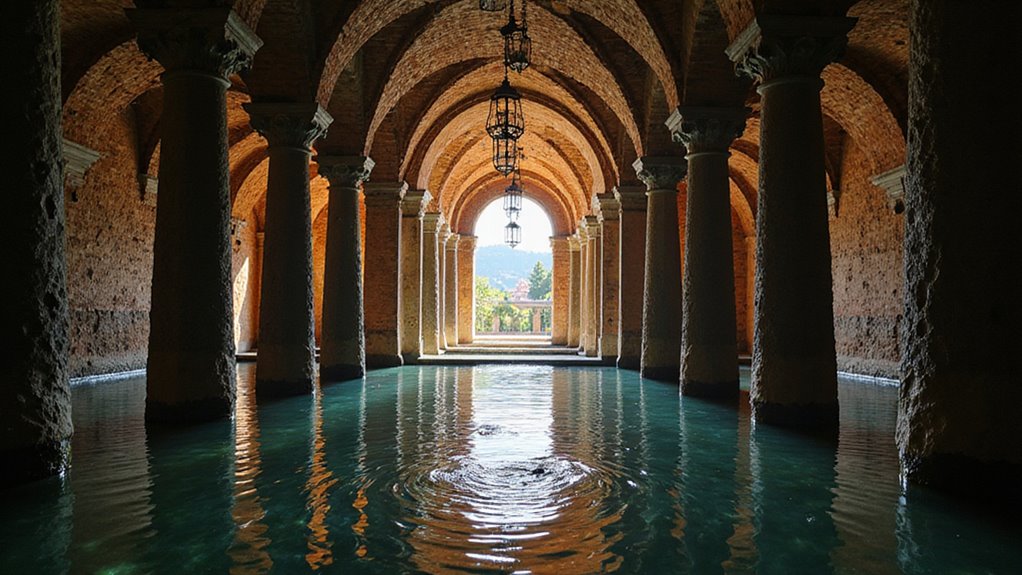
Sultanahmet Cistern offers cool, echoing chambers where low light, dripping water, and footsteps shape mood. Enter the cistern quietly, and feel the hush settle around you.
Sultanahmet pathways guide your steps toward columns, marble, and submerged reflections. Photography requires a steady hand, a tripod, patience, and respect for other visitors.
Lighting effects highlight capitals, row upon row of pillars, and the ancient floor. Basilica Cistern tours provide guides, audio, maps, and focused commentary for curious travelers.
Listen closely to note acoustic qualities that carry murmurs, drips, and distant footsteps. You should lower your voice, move slowly, and allow long exposures for striking images.
Historic attractions nearby include Topkapi Palace, Hagia Sophia, Sultanahmet Mosque, and the Hippodrome.
Plan your visit off-peak, confirm opening hours, purchase tickets online, and arrive prepared. Enjoy freedom to explore every aisle, take respectful photographs, linger at the Medusa heads, savor the silence, and perspective.
Planning a Back-to-Back Visit: Timing and Routes
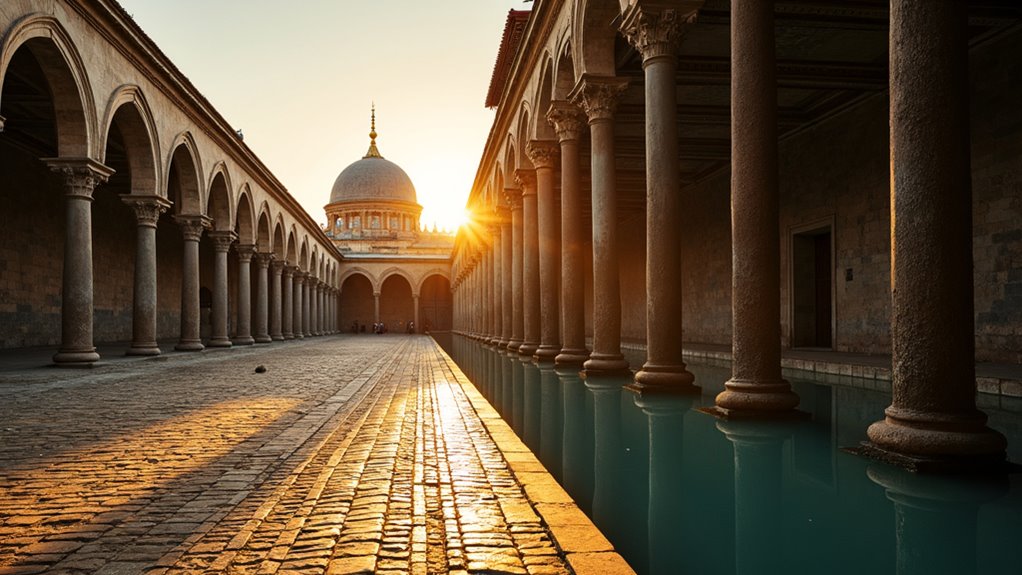
Topkapi Palace and Hagia Sophia sit within easy walking distance, so plan your route to avoid doubling back. Walk directly from Topkapi Palace gates toward Sultanahmet square, enjoying historic streets and open views. Begin visits early to dodge peak hours, soak in architecture, and keep momentum through sites. Transfer between monuments on foot, save time, absorb details, and embrace spontaneous detours.
Choose routes that favor efficient navigation, narrow alleys, promenades, and quieter side streets. Avoid retracing steps by mapping a loop that links Topkapi Palace, Basilica Cistern, and bazaars. Plan short breaks at cafes, shaded benches, and viewpoints to recharge, observe crowds, and reflect.
Consider alternative directions on busier days, adjust pacing, prioritize highlights, and keep options open. Take tram connections when necessary for longer transfers, stay flexible, save energy, and see more. Move confidently through streets, follow signs, trust your map, and enjoy a streamlined, liberating experience.
Tickets, Hours, Accessibility and Visitor Logistics
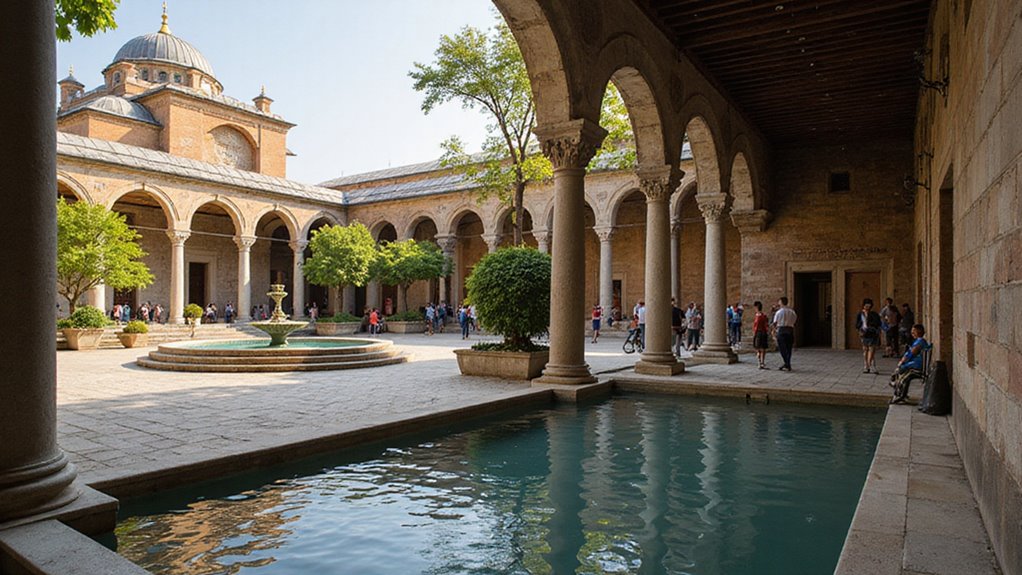
Basilica Cistern, Hagia Sophia, and Topkapi Palace each have different ticketing policies you’ll want to know. Visit the official sites first to confirm current hours, entry fees, and access rules.
Topkapi Palace offers multiple ticket types, timed entries for the Harem, and clear visitor services at the gate. Hagia Sophia provides flexible visits, but time slotting can simplify your plan and reduce waiting.
Basilica Cistern sells walk-in tickets, limits capacity, and posts accessibility details online for stair and ramp availability. Buy tickets online when possible to secure your preferred times, avoid lines, and gain relaxed movement through busy rooms.
Plan routes between sites by foot, tram, or short taxi rides for efficient travel and scenic views. Check accessibility options for wheelchairs, elevators, and assistance to stay independent and comfortable.
Take copies of confirmations, arrive early, and allow extra time for security checks and photography. Bring valid ID and payment.
Frequently Asked Questions
Are There Famous Legends or Ghost Stories Tied to Either Site?
Yes, you’ll encounter haunted legends and eerie tales about both sites; you’ll hear of phantom guards, sorrowful women, and whispering cistern spirits, and you’re free to explore, decide what to believe, and wander boldly alone.
Can Visitors Swim or Touch the Water in the Basilica Cistern?
About 1.5 million visitors yearly, and no—you can’t swim or touch the cistern water; ropes and signs protect fragile stone, support cistern maintenance, and guarantee water safety, but you can wander the walkways and photograph.
Is It Possible to Hold Weddings or Private Events at Topkapi Palace?
Yes, you can hold weddings and private events at Topkapi Palace, but venue availability is limited; you’ll need event planning, permits, and close coordination with museum authorities, respecting strict rules, fees, and scheduling—so plan early.
Is There Wi‑Fi or Reliable Mobile Reception Inside Topkapi Palace?
Yes, you’ll usually get decent mobile reception and limited museum Wi‑Fi, but don’t expect full coverage; technology access varies, so plan offline options if you value freedom and worry about internet availability during visits often.
Where Can I Buy Authentic Ottoman-Style Souvenirs Nearby?
You’ll find a bazaar so vast it could swallow continents; head to souvenir shops in Sultanahmet and Grand Bazaar, mingle with local vendors in small alleys, haggle freely, and pick handcrafted tiles, textiles, and jewelry.


